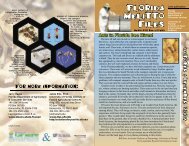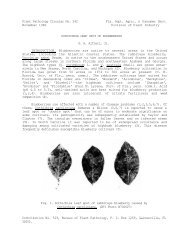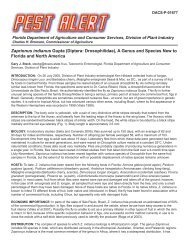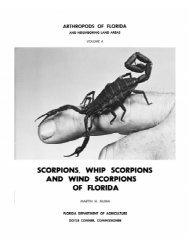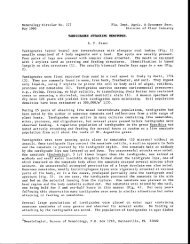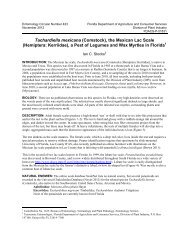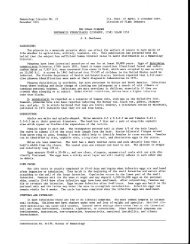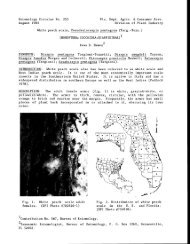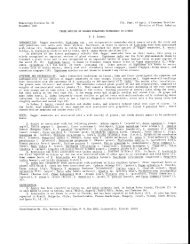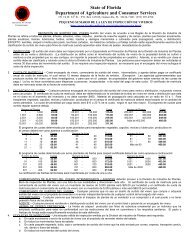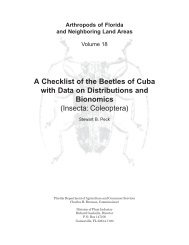BOTANY SECTION Compiled by Richard E. Weaver, Jr., Ph.D., and ...
BOTANY SECTION Compiled by Richard E. Weaver, Jr., Ph.D., and ...
BOTANY SECTION Compiled by Richard E. Weaver, Jr., Ph.D., and ...
You also want an ePaper? Increase the reach of your titles
YUMPU automatically turns print PDFs into web optimized ePapers that Google loves.
November-December 2008 TRI-OLOGY, Vol. 47, No. 6<br />
Page 2 of 12<br />
<strong>and</strong> up to 1 cm wide. Fragrant, cream-colored to white flowers, usually no wider than 0.5 cm,<br />
are borne in short, terminal racemes. The fruits, about 1 cm in diameter, are hard, globose to<br />
subglobose berries that turn red-orange when ripe. This slow-growing shrub, listed as<br />
threatened in the Preservation of Native Flora of Florida Act, is a native plant of extreme<br />
South Florida, the Bahamas <strong>and</strong> the Greater Antilles. Its compact habit, fragrant flowers <strong>and</strong><br />
ability to survive on the exposed limestone or s<strong>and</strong>y soils of coastal scrubl<strong>and</strong>s, dunes <strong>and</strong><br />
maritime hammocks make it an ideal addition to beachfront l<strong>and</strong>scapes. (Monroe County;<br />
B2008-774; Olga Garcia; 23 November 2008). (Correll <strong>and</strong> Correll 1982; Hammer 2004;<br />
http://miamidade.ifas.ufl.edu/).<br />
Porophyllum ruderale (Jacq.) Cass. (a genus of 28 species native mainly from the southwestern<br />
United States through Mexico into Andean South America). Compositae (Asteraceae).<br />
Yerba porosa, Bolivian cori<strong>and</strong>er, papalo. This distinctive genus is closely related to the<br />
marigolds (Tagetes) <strong>and</strong>, like them, has<br />
highly aromatic foliage. The achenes or<br />
cypselae (“seeds”) of this species are almost<br />
identical to those of the garden marigolds.<br />
This is a bushy annual plant growing to<br />
about a meter tall, native to dry mountains<br />
in Arizona <strong>and</strong> New Mexico south to the<br />
Andes as well as the West Indies. The<br />
leaves are alternate or subopposite, with<br />
blades 2-4 cm long, elliptic or ovate with<br />
entire or undulate margins. The petioles are<br />
slender <strong>and</strong> about the same length as the<br />
Porophyllum ruderale<br />
<strong>Ph</strong>otograph courtesy of Hugh D. Wilson<br />
http://botany.csdl.tamu.edu<br />
blades. The narrow, 2-3 cm long flower<br />
heads are quite curious. They are usually<br />
borne singly on long peduncles, with only<br />
five involucral bracts which, in fresh specimens, appear to be fused together into a tube, as<br />
are those of the marigolds; however, when they dry, the bracts of Porophyllum ruderale<br />
separate. The disc florets barely protrude from the involucre, resembling a small tuft of<br />
greenish or purplish fuzz. The plant is occasionally grown as a culinary herb, with a flavor<br />
like cilantro but more complex. It is easy to cultivate in full sun <strong>and</strong> well-drained soil. We<br />
have seen no reports that this species or any of its relatives are invasive. (Miami-Dade<br />
County; B2008-732; Olga Garcia; 2 November 2008). (Liogier 1997; Mabberley 1997).<br />
Psychotria sulzneri Small (a genus of 800-1500 tropical<br />
species, a few of which are also native to subtropical<br />
Florida). Rubiaceae. Shortleaf wild coffee, velvet-leaf<br />
wild coffee. A shrub to 2 m tall, this Florida native<br />
plant has blue-green, opposite leaves, 8-15 cm long <strong>and</strong><br />
up to 3 cm wide, with entire margins, acute to<br />
acuminate apices <strong>and</strong> prominent veins. The undersides<br />
of leaves are covered with dense, soft, short trichomes.<br />
Borne clustered in cymes, each flower has a calyx with<br />
five, tiny deltoid lobes <strong>and</strong> a greenish corolla. The fruit<br />
are red or orange drupes that are attractive to birds.<br />
Psychotria sulzneri<br />
<strong>Ph</strong>otograph courtesy of Atlas of Florida Vascular<br />
Plants http://www.plantatlas.usf.edu




